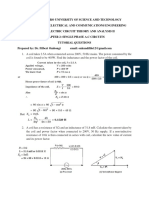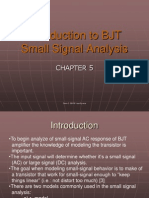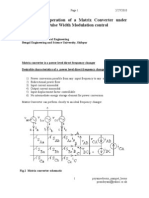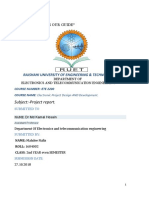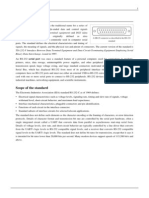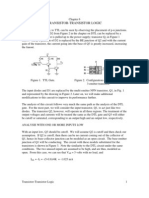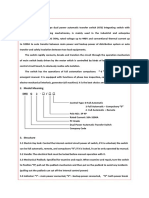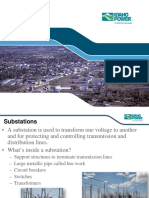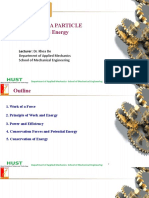HERIC
HERIC
Uploaded by
Minh NhậtCopyright:
Available Formats
HERIC
HERIC
Uploaded by
Minh NhậtCopyright
Available Formats
Share this document
Did you find this document useful?
Is this content inappropriate?
Copyright:
Available Formats
HERIC
HERIC
Uploaded by
Minh NhậtCopyright:
Available Formats
INTERNATIONAL JOURNAL of RENEWABLE ENERGY RESEARCH
Tarak Salmi et al., Vol.2, No.1, 2012
A Novel Transformerless Inverter Topology without
Zero-Crossing Distortion
Tarak Salmi*, Mounir Bouzguenda**, Adel Gastli**, Ahmed Masmoudi*
*Research Unit on Renewable Energies and Electric Vehicles, National Engineering School of Sfax
**Department of Electrical and Computer Engineering, College of Engineering, Sultan Qaboos University
Corresponding Author; Tarak Salmi,National Engineering School of Sfax , Tunisia, tarak_sel@yahoo.fr,
buzganda@squ.edu.om, gastli@squ.edu.om, a.masmoudi@enis.rnu.tn
Received: 31.12.2011 Accepted:04.02.2012
Abstract- The elimination of the transformer in solar photovoltaic inverters has reduced the size, the weight and the losses in
the system. On the other hand, the galvanic connection between the DC source and the grid generates leakage current through
the earth parasitic capacitance. The leakage current depends on both the inverter topology and the control strategy. Among the
existing inverters is the Highly Efficient and Reliable Inverter Concept (HERIC) topology that has low leakage current level
and high efficiency. However, this topology suffers from low frequency harmonics and current zero crossings distortions. To
eliminate these harmonics and distortions, a new transformerless inverter is proposed. The design is a conventional full bridge
inverter with an extra AC bypass. The bypass branch disconnects the inverter from the grid during the freewheeling period.
Simulation results indicate that the zero crossings distortions are totally eliminated and that the low frequency harmonics are
significantly reduced as a result of the appropriate applied control. Moreover, losses analysis of the proposed design yields an
efficiency of up to 94.14% and shows that the topology meets relevant standards.
Keywords- PV, inverter, transformerless, common mode voltage, leakage current, ripples, harmonics, zero crossings
distortions.
1. Introduction
Photovoltaic inverters can be divided into three main
system configurations: central inverters, string inverters and
module integrated inverters [1]. The central and string
inverters are based on the series and parallel connections of
many photovoltaic panels by means of long DC cables and
they exhibit problems such as:
- Mismatching losses by using one maximum power
point (MPP) control for a large group of PV
modules.
- Extra losses and risk of electrical arc in the long DC
wiring.
- Limited design flexibility.
Subsequently, the module integrated inverters are being
developed to overcome the above problems. Each PV
system has its dedicated small-sized inverter mounted on the
back of panel [2,3,4,5]. Therefore, mismatching losses are
significantly reduced since each module has its own MPP
tracking circuit. DC wiring is minimized and the safety of the
entire PV system is improved. In this case, the transformer
which is heavy, bulky and inappropriate for individual solar
panel installation would not be a requirement. Therefore,
new transformerless topologies have been developed and
commercially available. However, the transformerless
inverter creates a common-mode resonant circuit including
the filter, the inverter, the impedance of the grid and the DC
source ground parasitic capacitance. In this case, a common-
mode current is generated and superimposed to the grid,
hence increasing its harmonics content [6,7] and causing an
electromagnetic interference (EMI) between the PV system
and the grid [8,9,10]. In addition, even though, the
transformer ensures galvanic isolation between the grid and
the PV system and provides protection and suppresses the
leakage current between the PV and the earth, its omission
significantly increases the efficiency of the entire system [11-
12].
Accordingly, many standards have been deployed to set
a maximum allowed leakage current [10,13]. For instance,
INTERNATIONAL JOURNAL of RENEWABLE ENERGY RESEARCH
Tarak Salmi et al., Vol.2, No.1, 2012
141
the German DIN VDE 0126-1-1 mandates that a leakage
current of 30mA necessitates the disconnection of the
inverter from the grid within 0.3 second. Other standards,
such as IEEE 929-2000, IEC 61727, IEEE 1547, and EN
61000-3-2 have set the maximum DC current injected to the
grid to be between 0.5 % and 1%.
From the power quality point of view, standards such as
the IEC61000-3-2 and the IEEE 519-1992 [13,14] have set
the THD level to less than 5%.
In this paper, a new transformerless inverter topology
with a high efficiency, a low total harmonic distortion
(THD), low leakage current, and no zero crossings
distortions is presented.
The novel topology is based on the conventional full
bridge with two extra switches at the AC side. This extra
branch disconnects the inverter from the load when the zero
voltage of the PWM is applied to the load. Hence, it helps
keeping the power with the load which increases the
efficiency of the whole system. Besides, the DC current
injected to the grid is significantly reduced so does the
leakage current through the parasitic capacitance.
Section II reviews the well-known topologies, with a
special focus on the HERIC topology. In section III, the zero
crossings distortions (ZCD) phenomenon is introduced.
Section IV presents a detailed study and simulation of the
HERIC topology, while section V describes the efficiency
analysis and the simulation of the proposed topology. Section
VI recapitulates the results of the analysis and simulation
results. Conclusions and future work are summarized in
Section 7.
2. Review Of Transformerless Inverter Topologies
Ideal transformerless inverter generates constant
common mode voltage. However, if the voltage varies with
time, then a leakage current is produced. For the sake of
minimizing this leakage current, different topologies were
studied in details [1, 3, 4, 8, 11, 15,16]. Among these are the
full bridge with bipolar PWM, the half bridge, HERIC, H5,
H6 and NPC all of which experience certain drawbacks
which are discussed next.
2.1. Full Bridge Inverter
The full-bridge inverter with bipolar PWM [6, 15,16]
causes high switching losses and large current ripples and
does not eliminate the DC current injected into the grid that
has the tendency of saturating the transformer cores. Even
though, this topology is being used in some commercial
transformerless inverters, it still presents quite low efficiency
according to the European standards due to the losses caused
by the double switching frequency [8].
2.2. Half Bridge Inverter
The half bridge inverter, on the other hand, requires a
high input voltage and a boost converter in the DC side that
would increase the inverter size and cost and reduce its
efficiency down to 92% [6,8]. For this reason the half bridge
is not recommended.
2.3. HERIC Inverter
Meanwhile, as detailed in [3, 15], the HERIC topology,
shown in Fig. 1, combines the advantages of the unipolar and
bipolar modulations. It has a three level output voltage, a
high efficiency and a low leakage current. However, the
HERIC topology presents low frequency harmonics and does
not allow for reactive power flow. This is due to the control
strategy.
2.4. H5 Inverter
This topology is based on the full bridge with an extra
switch on the DC side. In this topology, the upper switches
operate at grid frequency while the lower switches operate at
high frequency [16,17]. The extra switch operates at high
frequency and guarantees the disconnection of the DC source
from the grid. This topology has two main disadvantages.
The first one is the high conduction losses due to the fact that
three switches operate simultaneously. The second one is that
the reactive power flow is not possible due to the control
strategy [16].
2.5. NPC Inverter
The NPC inverter topology is being considered as an
attractive solution in case of transformerless systems. This
inverter has the advantages of no internal reactive power
flow, a three level inverter output voltage and a low leakage
current [6,16]. However, it requires an input voltage as high
as twice the input voltage required by other topologies and a
boost stage which increases inverter losses and size.
2.6. Flying Inductor Inverter
The Flying inductor inverter is also known as the
Karschny inverter. It consists of a buck-boost circuit and an
inverter and requires additional semiconductor devices in the
current path as well as high inductors to store the entire
inductive energy [16]. These additional components reduce
the overall efficiency and increase the cost and size of the
inverter.
3. Review Of Zero-Current Crossing Distortion
The zero-current distortions are known to cause damage
to certain equipment such as computers and televisions [14].
It looks like a notch taken out of the sine wave near the zero-
crossings. In this case, the inverter current waveform can be
described as a superposition of a pure sine wave to which a
distorting wave form d(x) is added. This waveform is
analytically represented as follow:
| | | |
| | | |
2 , 2 , ), sin(
2 , , 0 , 0
) (
e
e
=
t u t t u t
u t t u t
ZCD ZCD
ZCD ZCD
x x
x
x d
(1)
In this equation,
ZCD
is the zero-crossings distortions
notch angle.
INTERNATIONAL JOURNAL of RENEWABLE ENERGY RESEARCH
Tarak Salmi et al., Vol.2, No.1, 2012
142
Fourier analysis of this wave form is used to find the
coefficients (a
n
and b
n
) and the harmonics that cause the
electromagnetic emission and interference by the inverter,
and to design the proper filter [14].
( ) ( )
( )
=
=
|
|
.
|
\
|
+
+
+
=
1 n for , 1 2 cos
2
1
3,5,7,... n for ,
1
1 cos
1
1 cos
1
1
1
1 1
ZCD
ZCD ZCD
n
n
n
n
n
n n
a
u
t
u u
t
(2)
and
( ) ( )
( )
=
=
|
|
.
|
\
|
+
+
=
1 n for ,
2
1
3,5,7,... n for ,
1
ZCD
sin2
ZCD
2
1 n
ZCD
1 n cos
1 n
ZCD
1 n sin
b
n
t
t
(3)
The magnitude Mn of the n
th
order harmonic defined in (4) is
a function of the harmonics number n and the zero-crossing
angle
ZCD.
2 2
n n n
b a M + =
(4)
The zero-crossings distortions create inductor-voltage
spikes. These spikes are produced because of the sudden
change in the current during the zero-crossing period. For
sensitive power semiconductor devices, excessive current
can flow if the voltage spikes exceed the breakdown voltage
of the semiconductor devices.
This zero crossings distortions are due to many
phenomena, one of which is the coincidence of the switching
frequency with the filter resonance frequency [18]. However,
the control strategy of the inverter is the main source of such
distortions.
So far, different topologies were discussed in light of the
issues associated with the reviewed topologies such as
leakage current and zero-crossings distortions.
The HERIC topology that has many features will be used
as a reference hereafter. Therefore; the following section
presents a detailed study and simulation of the HERIC
inverter.
4. HERIC Transformerless Inverter Topology
4.1. HERIC topology Common Mode Current
For the HERIC topology, shown in Fig.1, the common-
mode voltage (v
cm
) and current (i
cm
) through the capacitance
CGPV between the photovoltaic array and earth are:
2
BO AO
cm
v v
v
+
=
(5)
And
dt
cm
GPV cm
dv
C i =
(6)
Voltages v
AO
and v
BO
are controlled by the four switches
(S
1
throughS
4
).
Fig.1. HERIC topology.
When the upper switch S
1
or S
3
is ON, the corresponding
voltage is v
IN
. However, when the lower switch S
2
or S
4
is
ON, the corresponding voltage is zero. During the positive
half wave, S
6
is turned ON and is used in the freewheeling
period of S
1
and S
4
. When both S
1
and S
4
are ON, v
AO
=v
IN
and v
BO
=0. Therefore, the applied common mode voltage is:
2
IN
cm
v
v =
(7)
Table 1. Exhibits the switching principle of the HERIC
inverter topology and shows that vcm is always constant.
Vector N P i
grid
<0 i
grid
>0
S1 OFF OFF OFF OFF
S2 ON OFF OFF OFF
S3 ON OFF OFF OFF
S4 OFF ON OFF OFF
S5 OFF OFF ON OFF
S6 OFF OFF OFF ON
v
AO
0 VIN NA
*
NA
*
v
BO
v
IN
0 NA
*
NA
*
v
cm
v
IN
v
IN
v
IN
v
IN
*Not Applicable (NA)
Therefore, according to equation 2, the common mode
current i
cm
is zero.
The performance of the HERIC inverter in terms of icm
and icm was simulated using non ideal power electronic
devices and the results are shown in Fig. 2.
It is clear that the common mode voltage is small and the
leakage current is low. However, if the switching actions
take place simultaneously, then the common mode voltage
would be totally eliminated [17].
During the freewheeling period, S1 and S4 are turned
off, vAO decreases to zero and vBO increases until the diode
of S5 switches ON. If during the switching process, the
magnitude of the increase in vBO is equal to that of the vAO
decrease, then Vcm satisfies equation (7).
INTERNATIONAL JOURNAL of RENEWABLE ENERGY RESEARCH
Tarak Salmi et al., Vol.2, No.1, 2012
143
During toff, the inductor current flows through S6 and
the diode of S5. The voltage applied to the inductor is (-
vgrid) [8], vAO=0, vBO=vIN and the common mode voltage
is:
2
IN
cm
v
v =
(8)
Fig.2. HERIC topology simulation results.
4.2. HERIC topology Zero Crossings Distortions
For the HERIC inverter topology, the simulation results
depicted in Fig. 2 (b and e) show a short break of 0.8 ms at
the current zero-crossings. In this topology, the main
switches utilize the PWM control strategy. The AC bypass
branch operates at the line-frequency switching order.
Despite the fact that this reduces losses, it also interrupts the
current flow near the zero crossings and the current may not
be well controlled there, which results in a distorted
waveform and inductor voltage spikes as shown in Fig.2 (a).
However, these issues can be solved with improved
control strategies and topologies that present smooth four-
quadrant operation near the zero crossings [14].
5. Proposed Transformerless Inverter Topology
5.1. Topology and Principles of Operation
The proposed topology is shown in Fig. 3 and consists of
six IGBTs, six freewheeling diodes and one diode-bridge on
the AC side.
The switching principles are similar to those of the
HERIC topology presented in Table 1, except for the high
switching frequency of S5 and S6. During the positive grid
period, S1 and S4 are switched ON and OFF at a high
switching frequency, while S6 is OFF and ON, respectively.
In this case, when S1 and S4 are turned OFF, the
freewheeling current finds its path through D3, S6 and D2 as
indicated by the dotted line in Fig. 4 and Fig.5. For the
negative half cycle, the freewheeling path is through D1, S5
and D4.
Fig.3. Proposed transformerless inverter topology.
Fig.4. Proposed topology showing the current path during
the positive half cycle (dotted line).
5.2. Leakage Current and Zero Crossing Distortions
For the proposed inverter topology, the simulation
results are included in Fig. 6 and show that the leakage
current does not exceed 21.10 mA, which is within the 30
mA limit set by the DIN VDE 0126-1-1standard.In fact, the
common mode voltage varies from 165 V to 184 V. This
variation is low and leads, therefore, to a low leakage current
level. In addition, the zero crossings distortions are
eliminated.
Fig.5. Proposed topology showing the current path during
the freewheeling period of S1-S4 (dotted line).
In the AC side, the bypass branch switches at the same
frequency of S1-S4.This means no sudden switching exists at
the end of each half cycle and the bypass branch does not
interrupt the flow of current. Therefore, the inductor voltage
INTERNATIONAL JOURNAL of RENEWABLE ENERGY RESEARCH
Tarak Salmi et al., Vol.2, No.1, 2012
144
spikes would not appear as shown in Fig.6 (a). Such a control
strategy also eliminates the zero-crossings distortions as
shown in Fig. 6 (b and e), but at the expense of a small
increase in the current ripples which can be easily removed
using a simple EMI filter.
5.3. Efficiency
The efficiency of the proposed topology was estimated
based on the power switches losses: switching, and ON-state
losses.
Fig.6. Proposed topology simulation results.
IGBT Switching Losses
The total switching power losses (P
tot-sw
) can be defined
as the ratio of the total switching energy losses (E
tot
) over the
switching period. E
tot
is usually specified in the device
datasheet and includes both switching and diode reverse
recovery energy losses. Then, P
tot-sw
can be defined as:
tot s
sw tot
E f P =
(9)
By convention, the switching energy available in the
datasheets is for a specified test voltage and current (V
test
and
I
test
). To account for actual operating voltage and current, a
correction coefficient (Y
0
) is needed and the switching losses
are expressed as [19, 20]:
( )
0
Y P P
Datasheet tot tot
=
(10)
With:
1
0
0
t
= =
test test
bus
g
I
I
V
V
K Y
(11)
Where K
g
, V
bus
and I
0
are the correction factor, bus
voltage and peak load current, respectively.
Combining the above three equations yields the
following equation for the IGBT switching power losses:
) (
t
Datasheet tot
sw tot
E
s
f
P =
(12)
IGBT Conduction Losses
The ON-state power losses for one switch and for the
freewheeling diodes are [21]:
( ) )) ( (
off d
on d
f r ce L
g
t t t t dT V I
T
N
s
P
+ + + = (13)
And
( ) )) ( ) 1 ((
off d
on d
f r L
g
t t t t T d
F
V I
T
N
fd
P
+ + + = (14)
where:
I
L
: load current, RMS value.
V
ce
: IGBT emitter to collector voltage.
d: duty cycle.
f
s
: switching frequency.
T
s
: switching period.
T
g
: grid period.
t
r
: rise time.
t
f
: fall time.
t
d-off
: turn-off delay time.
t
d-on
: turn-on delay time.
V
F
: diode forward voltage drop.
N: Switching times per grid cycle.
Diode Power Losses
Since the power dissipated by each diode during one
switching period is not provided in the datasheet, it must be
estimated. In fact, the power dissipated in one diode is the
sum of the power dissipated during the on-state phase, the
off-state phase and the commutation phase [22,23].The diode
power losses during the ON-state and the OFF state and the
diode reverse recovery losses are respectively:
F
d V I P
F on
=
(15)
) 1 (
R
d V I P
R off
=
(16)
2
1
rr
f Q V P
R rec
=
(17)
Where Q
rr
is provided in the device datasheet and
defined as [23]:
F Qr rr
I K Q =
(18)
where:
K
Qr
: a function of di/dt.
I
F
: diode forward current.
INTERNATIONAL JOURNAL of RENEWABLE ENERGY RESEARCH
Tarak Salmi et al., Vol.2, No.1, 2012
145
V
F
: diode forward voltage.
I
R
: diode reverse current.
V
R
: diode reverse voltage.
Q
rr
: reverse recovery charge.
f
s
: switching frequency.
Combining (12) through (19) yields the total power
losses of the semiconductor devices-IGBT and AC bridge
diodes, as shown below:
( ) )
2
1
1 ( 2
3 3 3
s rr R R R F L
sw tot total
f Q V d V I d V I
fd
P
s
P P P
+ + +
+ + =
(19)
6. Results
The above equations are used to estimate the losses of
the proposed topology as well as those of the HERIC
topology. In the losses estimation, six non-ideal IGBTs
(IRG4PH50KD) and four non ideal diodes (HFA30PB120)
from the HEXFRED family are used. The parameters of
selected switching devices are listed in Table 2 while the
estimated losses are given in Table 3.
Table 2. Power Loss Estimation Parameters
Parameter Value Unit
I
L,rms
25.22 A
V
ce
2.77 V
d 50.00 %
T
g
20.00 ms
t
f
390 ns
t
d-off
67 ns
I
PV,avg
14.38 A
V
DC
350 V
t
d-on
310 ns
V
F
2.30 V
N 160
I
R
1.50 mA
V
R
800 V
Q
rr
1838 nC
f
s
8 kHz
t
r
0.72 ns
From Table 3, it is clear that the conduction losses for
the proposed topology are lower than those of the HERIC
topology. This is due to the fact that, for the HERIC
topology, one switch (S
5
or S
6
) and one freewheeling diode
remain ON during the entire grid half cycle. However, in the
proposed topology, these switches are subject to grid current
for much shorter time. On the other hand, even though there
are additional diodes losses, the overall losses in the
proposed topology were almost equal to and even a bit lower
than those of the HERIC and therefore, a slight improvement
in the overall efficiency is obtained. Further improvement is
possible to achieve if better diodes with lower power losses
are used.
The proposed inverter topology has several features,
namely the elimination of the zero crossings distortions, low
THD, high efficiency and low leakage current. The
analytical and simulation results showed that this topology
has an efficiency of 94.14%, a THD of 2.62% and a leakage
current of 22.10mA. For the HERIC topology, the efficiency
and THD are 94.13% and 3.26%, respectively.
From power quality point of view and based on the
analysis presented in Section III, it is anticipated that the low
frequency harmonics are significantly reduced as shown in
Fig. 7.
Fig.7. Comparison of low order harmonics in the HERIC and
proposed topologies.
It is obvious that, for the proposed topology, low order
harmonics are much less than those of the HERIC topology.
This represents another advantage for the proposed topology.
Table 3. Losses Breakdown for the HERIC and the Proposed
Topologies
HERIC Proposed
Conduction losses (W) 295.75 220.30
Switching losses (W) 112.80 111.00
Diodes losses (W) 0.00 74.77
Total losses (W) 297.55 295.07
Input power (W) 5034.00 5034.00
Efficiency (%) 94.09 94.14
7. Conclusion
In this paper, major transformerless topologies were
reviewed in terms of their advantages and disadvantages. It
was found that these topologies suffer from some drawbacks
such as the leakage current and zero crossings distortions.
The leakage current is generated when the transformer is
omitted. However, the zero crossings distortions are due to
the applied control strategies. Accordingly, a novel
transformerless inverter topology was developed and a
detailed analysis of its efficiency was carried out. It was
found that the adopted topology as well as the control
strategy has revealed that the zero crossings distortion was
definitely eliminated, the efficiency has been improved and
the low frequency harmonics were significantly reduced.
Following these preliminary results, a prototype is under
design to confirm experimentally the above mentioned
features of the proposed topology.
References
[1] Fritz Schimpf, Lars E. Norum, Grid Connected
Converters for Photovoltaic, State of the Art, Ideas for
Improvement of Transformerless Inverters,
NORPIE/2008, Nordic Workshop on Power and
Industrial Electronics, June 9-11, 2008, pp.1-5.
INTERNATIONAL JOURNAL of RENEWABLE ENERGY RESEARCH
Tarak Salmi et al., Vol.2, No.1, 2012
146
[2] T. Kerekes, R. Teodorescu, M. Liserre, Common Mode
Voltage in case of Transformerless PV Inverters
Connected to the Grid, IEEE International Symposium
on Industrial Electronics, June 30th- July 2nd 2008, pp.
2390 - 2395.
[3] W.T. Franke, N. Oestreich, F.W. Fuchs, "Comparison of
Transformerless Converter Topologies for Photovoltaic
Application Concerning Efficiency and Mechanical
Volume", IEEE International Symposium on Industrial
Electronics, 2010, pp.724-729.
[4] Oscar Lopez, Remus Teodorescu, Francisco Freijedo,
Jesus Doval-Gandoy, "Eliminating Ground Current in a
Transformerless Photovoltaic Application", IEEE
Transactions on Energy Conversion, Vol. 25, No 1, Mar.
2010, pp. 140-147.
[5] W. Bower and J. Wiles, Investigation of Ground-Fault
Protection Devices for Photovoltaic Power System
Applications, Proceedings of the 28th IEEE Conference
on Photovoltaic Specialists, 2000, pp. 1378-1383.
[6] Roberto Gonzlez, Eugenio Guba, Jess Lpez, and Luis
Marroyo, Transformerless Single-Phase Multilevel-
Based Photovoltaic Inverter, IEEE Transactions on
Industrial Electronics, Vol. 55, No. 7, July 2008,
pp.2694-2702.
[7] Lin Ma, Fen Tang, Fei Zhou, Xinmin Jin and Yibin Tong,
"Leakage Current Analysis of a Single-Phase
Transformer-less PV inverter connected to the grid",
Proceedings of the IEEE International Conference on
Sustainable Energy Technologies, 24-27 Nov. 2008,
pp.285-289.
[8] Roberto Gonzalez, Jesus Lopez, Pablo Sanchis, Eugenio
Gubia, Alfredo Ursua and Luis Marroy, High-Efficiency
Transformerless Single-phase Photovoltaic Inverter,
Proceedings of the 12th IEEE Conference on Power
Electronics and Motion Control, 30 Sep. 2006, pp.1895-
1900.
[9] Valentini, M. Raducu, A. Sera, D. Teodorescu, R., PV
inverter test setup for European efficiency, static and
dynamic MPPT efficiency evaluation, Proceedings
of11th International Conference on Optimization of
Electrical and Electronic Equipment, OPTIM 2008,
Printed on CD.
[10] T. Kerekes, R. Teodorescu, and U. Borup,
Transformerless Photovoltaic Inverters Connected to the
Grid, Proceedings of the APEC 2007, Feb. 25 - March
01, pp. 1733-1737.
[11] Rodrguez, Gerardo Vzquez, Emiliano Aldabas, A
new high-efficiency single-phase transformerless PV
inverter topology, IEEE Transactions on Industrial
Electronics, June 2009, pp.1-5.
[12] Huafeng Xiao, Shaojun Xie, Leakage current
analytical model and application in single-phase
Transformerless photovoltaic grid-connected inverter,
IEEE Transaction on Electromagnetic Compatibility,
Vol.52, No. 4, Nov 2010, pp.902-913.
[13] IEEE Recommended Practices and Requirements
for Harmonic control in Electrical Power Systems, IEEE
Standard 519-1992.
[14] Andrew Kotsopolos, Peter J.M. Heskes, Mark
J.Jasen, Zero-Crossing Distortion In Grid-Connected PV
Inverters, IEEE Transactions on Industrial Electronics,
Vol. 52, No.2, April 2005, pp. 558-565.
[15] J. Myrzik, M. Calais, "String and Module Integrated
Inverters for Single Phase Grid Connected Photovoltaic
Systems- A Review", Proceedings of the IEEE
Conference on Power Tech, Bologna, Italy, 23-26 June
2003, Vol.2.
[16] Samuel Vasconcelos, Araujo, Peter Zacharias,
Regine Mallwitz, High Efficient Single-Phase
Transformerless Inverter for Grid-Connected
Photovoltaic Systems, IEEE Transactions on Industrial
Electronics, Vol. 57, No. 9, Sep. 2010, pp. 3118-3128.
[17] G. Buticchi, G. Franceschini, E. Lorenzani,
"Compensation Strategy of Actual Commutations for PV
Transformerless Grid-Connected Converters",
Proceedings of the XIX International Conference on
Electrical Machines, Rome 6-8 Sept.2010, pp. 1-5.
[18] Sushant Kumar Pattnaik, K.K Mahapatra, Power
loss Estimation for PWM and Soft-switching Inverter
using RDCLI, On Proceeding of IMECS, Vol. 2, Mar
17th-19th 2010.
[19] F. Casanellas, Losses in PWM Inverters Using
IGBTs, Proceedings in IEEE Power Electronics
Applications, Vol. 141, No. 5, Sept. 1994, pp. 235-239.
[20] Alberto Guerra, Kohji Andoh, Silvestro Fimiani,
Ultra-Fast Recovery Diodes Meet Todays
Requirements For High Frequency Operation and Power
Ratings in SMPS Applications, International Rectifier,
Jul. 14th 2000, pp. 1-9.
[21] H.F Xiao, S.J. Xie, C. Yang, R.H. Huang, "An
Optimized Transformerless Photovoltaic Grid-Connected
Inverter", IEEE Transactions on Industrial Electronics,
Vol.99, June 2010, pp. 1-9.
[22] YUAN Liqiang, ZHAO Zhengming, YANG Zhi,
Power Losses for IGCTs and Diodes in MV Three-level
Inverters, Proceedings of the IEEE International
Conference on Electronics and Drives Systems, Nov.
2005, pp. 205-208.
[23] Tanel Jalakas, Dmitri Vinnikov, Prediction of
Semiconductor Losses in a High-Power High-Voltage
DC/DC Converter, Doctoral School of Energy-and Geo-
Technology, Jan. 15th-20th 2007, Kuressaare, Estonia,
pp. 114-117.
You might also like
- Quick Installation Manual IP GatewayDocument28 pagesQuick Installation Manual IP GatewayMinh Nhật100% (2)
- CHAPTER 2 Single Phase Power Tutorial QuestionsDocument17 pagesCHAPTER 2 Single Phase Power Tutorial QuestionsFilbert OmbongiNo ratings yet
- Lab 1-9Document36 pagesLab 1-9HassanAhmed124No ratings yet
- Series and Parallel Operation of ThyristorsDocument4 pagesSeries and Parallel Operation of ThyristorsAzImmNo ratings yet
- Sample Wiring Diagram-InNCOMDocument2 pagesSample Wiring Diagram-InNCOMMinh Nhật100% (2)
- Electrical Drawings Checklist UpdatedDocument13 pagesElectrical Drawings Checklist UpdatedMehboob Alam100% (1)
- An Expert of Energy Storage SolutionsDocument53 pagesAn Expert of Energy Storage SolutionsDoan Anh Tuan100% (1)
- 00707781Document6 pages00707781sandeepbabu28No ratings yet
- Z. Stojkovic - Computer-Aided Design in Power EngineeringDocument433 pagesZ. Stojkovic - Computer-Aided Design in Power EngineeringMário NY AmaroNo ratings yet
- Power Electronics Question BankDocument20 pagesPower Electronics Question BankNitesh KumarNo ratings yet
- Edc Unit 5 Small Signal Low Freq BJT ModelsDocument61 pagesEdc Unit 5 Small Signal Low Freq BJT ModelsSandeep PatilNo ratings yet
- Intro To BJT Small SignalDocument35 pagesIntro To BJT Small SignalVallestero SiegfredNo ratings yet
- Chap3 State Variable ModelsDocument47 pagesChap3 State Variable ModelsEngr Abdul QadeerNo ratings yet
- ExercDocument22 pagesExercThiago Moura100% (1)
- Solarmine Whitepaper Update 15Document16 pagesSolarmine Whitepaper Update 15Matzebo100% (1)
- Control Systems and PLC-sample-question-paper (Msbte-Study-Resources)Document5 pagesControl Systems and PLC-sample-question-paper (Msbte-Study-Resources)shubhampawaskar1313No ratings yet
- Modeling and Simulation of Reluctance Motor Using Digital ComputerDocument5 pagesModeling and Simulation of Reluctance Motor Using Digital ComputerroyourboatNo ratings yet
- Practice Questions DC CircuitsDocument11 pagesPractice Questions DC CircuitsDeepankar Synthesizer Playist DspNo ratings yet
- Switching Loss Calculation FairchildDocument16 pagesSwitching Loss Calculation Fairchildabima385elNo ratings yet
- bee-EXPERIMENT 5 ZenerDocument6 pagesbee-EXPERIMENT 5 ZenerKzenetteNo ratings yet
- Rain Sensor ModuleDocument5 pagesRain Sensor ModuleBernard BearNo ratings yet
- Project Status Review Semester: 7 EE (Group No: 2) Project I (2170001)Document51 pagesProject Status Review Semester: 7 EE (Group No: 2) Project I (2170001)UmangNo ratings yet
- Matrix Converter PrincipleDocument20 pagesMatrix Converter Principleprasidsyam100% (1)
- Solar-Powered Battery Charging With Highly Efficient Buck ConverterDocument20 pagesSolar-Powered Battery Charging With Highly Efficient Buck ConverterSusanNo ratings yet
- Lecture 12 (ADC) Rv01Document47 pagesLecture 12 (ADC) Rv01Amirul HaqimieNo ratings yet
- Design Modelling Analysis and Implementation of Two Phase Interleaved Buck DC DC ConverterDocument8 pagesDesign Modelling Analysis and Implementation of Two Phase Interleaved Buck DC DC ConverterInternational Journal of Innovative Science and Research TechnologyNo ratings yet
- Electronic Card Lock System Final Year Ece Project ReportDocument17 pagesElectronic Card Lock System Final Year Ece Project ReportSunny Prasanth100% (3)
- CH 2 NotesDocument24 pagesCH 2 NotesJahangeer SoomroNo ratings yet
- CCRI PoS Report 2022Document30 pagesCCRI PoS Report 2022holmudekke100% (1)
- Design Considerations For System-Level ESD Circuit ProtectionDocument6 pagesDesign Considerations For System-Level ESD Circuit Protectionmincingthought6612No ratings yet
- DC ChoppersDocument38 pagesDC Chopperspsoumya50% (2)
- Buck Converter Using ArduinoDocument12 pagesBuck Converter Using ArduinoaaqibNo ratings yet
- EE3007-SMART GRID-1859366080-Smart Grid Notes PDF NWDocument44 pagesEE3007-SMART GRID-1859366080-Smart Grid Notes PDF NWregina325clg100% (1)
- Mini Project InverterDocument52 pagesMini Project InverterraycrossharmaNo ratings yet
- Mason's RuleDocument37 pagesMason's RuleHammad KhiljiNo ratings yet
- Dynamic Modeling and Analysis of Three Phase Self-Excited Induction Generator Using Generalized State Space ApproachDocument8 pagesDynamic Modeling and Analysis of Three Phase Self-Excited Induction Generator Using Generalized State Space ApproachAnonymous On47lKiNo ratings yet
- A Critical Review of Comparative Global Historical Energy Consumption and Future Demand The Story Told So FarDocument19 pagesA Critical Review of Comparative Global Historical Energy Consumption and Future Demand The Story Told So FarCharina Anggraeni100% (1)
- High-Gain Differential Amplifier DesignDocument21 pagesHigh-Gain Differential Amplifier DesignBodhayan PrasadNo ratings yet
- Buck ConverterDocument8 pagesBuck Converterhamza abdo mohamoudNo ratings yet
- Hirth 2013 Market Value Renewables Solar Wind Power Variability PriceDocument45 pagesHirth 2013 Market Value Renewables Solar Wind Power Variability PriceAyoub EnergieNo ratings yet
- Energy Consumption of Cryptocurrencies Beyond BitcoinDocument4 pagesEnergy Consumption of Cryptocurrencies Beyond BitcoinZolfaqar DaneshiNo ratings yet
- Bipolar Stepper Motor Driver 74194Document12 pagesBipolar Stepper Motor Driver 74194mekuannintmesfin100% (2)
- Design of Two Switch Buck Boost ConverterDocument16 pagesDesign of Two Switch Buck Boost ConvertermithunprayagNo ratings yet
- Simulation and Arduino Hardware Implementation of DC Motor Control Using Sliding Mode ControllerDocument6 pagesSimulation and Arduino Hardware Implementation of DC Motor Control Using Sliding Mode Controllermiftah fadhliNo ratings yet
- Matrix Converter ThesisDocument148 pagesMatrix Converter ThesisHollie Rosa100% (1)
- Water LevelDocument36 pagesWater LevelPreet ChahalNo ratings yet
- Chapter 4 DC To AC Conversion (INVERTER)Document46 pagesChapter 4 DC To AC Conversion (INVERTER)xuanbac198467% (3)
- Water Automation Project ReportDocument23 pagesWater Automation Project ReportMahdee NafisNo ratings yet
- Principle of Ward Leonard MethodDocument2 pagesPrinciple of Ward Leonard MethodHazizi KhairyNo ratings yet
- L-12 (SS) (Ia&c) ( (Ee) Nptel) - P-I-D ControlDocument10 pagesL-12 (SS) (Ia&c) ( (Ee) Nptel) - P-I-D ControlRaymond EsmeraldaNo ratings yet
- Lecture 1 SlidIntroduction To Power ElectronicseDocument37 pagesLecture 1 SlidIntroduction To Power ElectronicseCIMUT125No ratings yet
- Different Modeling Aspects and Energy Systems of Unified Power Quality Conditioner (UPQC) - An Overview (#168251) - 148354Document8 pagesDifferent Modeling Aspects and Energy Systems of Unified Power Quality Conditioner (UPQC) - An Overview (#168251) - 148354Marshallchiyan PhilipNo ratings yet
- 8051 Project LCD InterfacingDocument7 pages8051 Project LCD InterfacingShailesh Sankdasariya100% (5)
- Chopper 2003Document40 pagesChopper 2003Agus SetyawanNo ratings yet
- Power Electronics and Motor Control PDFDocument563 pagesPower Electronics and Motor Control PDFAnonymous qdJOxst100% (3)
- LDICA 10M QuestionsDocument2 pagesLDICA 10M Questionsdeepa reddyNo ratings yet
- Scope of The Standard: A DB-25 Connector As Described in The RS-232 StandardDocument11 pagesScope of The Standard: A DB-25 Connector As Described in The RS-232 Standardcorneliusflavius7132100% (3)
- Transistor-Transistor LogicDocument22 pagesTransistor-Transistor LogicSameeha Akram100% (1)
- Improved Indirect Power Control (IDPC) of Wind Energy Conversion Systems (WECS)From EverandImproved Indirect Power Control (IDPC) of Wind Energy Conversion Systems (WECS)No ratings yet
- MCCB Selection For 75KW IE3 MotorDocument1 pageMCCB Selection For 75KW IE3 MotorMinh NhậtNo ratings yet
- How To Select Motor Protection Component When Using IE3 MotorDocument1 pageHow To Select Motor Protection Component When Using IE3 MotorMinh NhậtNo ratings yet
- Zelio Control Relays - RM22TG20 DatasheetDocument7 pagesZelio Control Relays - RM22TG20 DatasheetMinh NhậtNo ratings yet
- MEP Planning ManualDocument118 pagesMEP Planning ManualMinh NhậtNo ratings yet
- Micrologic For ACB MVSDocument8 pagesMicrologic For ACB MVSMinh NhậtNo ratings yet
- Kavacha Bro Eng May2013Document28 pagesKavacha Bro Eng May2013Minh NhậtNo ratings yet
- Atys T Nmo 541995d EN PDFDocument66 pagesAtys T Nmo 541995d EN PDFMinh NhậtNo ratings yet
- Useful Vocabulary For The Resume and InterviewDocument10 pagesUseful Vocabulary For The Resume and InterviewMinh NhậtNo ratings yet
- Integration in Access Control Systems: Putting Together The Pieces of An Integrated Access Control SystemDocument17 pagesIntegration in Access Control Systems: Putting Together The Pieces of An Integrated Access Control SystemMinh NhậtNo ratings yet
- Effects of High or Low VoltageDocument2 pagesEffects of High or Low VoltageMinh NhậtNo ratings yet
- A Generalized Multilevel Inverter TopologyDocument8 pagesA Generalized Multilevel Inverter TopologyMinh NhậtNo ratings yet
- FFT2 AlgorithmDocument41 pagesFFT2 AlgorithmMinh NhậtNo ratings yet
- SSPre PFIEV Chapter1 2012Document174 pagesSSPre PFIEV Chapter1 2012Minh NhậtNo ratings yet
- L01Document8 pagesL01Minh NhậtNo ratings yet
- FFT2 AlgorithmDocument41 pagesFFT2 AlgorithmMinh NhậtNo ratings yet
- Digital Signal Processing: Frequency Response Digital Filter DesignsDocument23 pagesDigital Signal Processing: Frequency Response Digital Filter DesignsMinh NhậtNo ratings yet
- CCS Users GuideDocument226 pagesCCS Users Guideapi-3860349No ratings yet
- SMGQ2Document10 pagesSMGQ2CarlosNo ratings yet
- TT Ground Fault Analysis and Protection in PV Arrays Tech TopicDocument4 pagesTT Ground Fault Analysis and Protection in PV Arrays Tech Topicabhi_26tNo ratings yet
- Scad ADocument57 pagesScad AARVINDNo ratings yet
- Lazard's Levelized Cost of StorageDocument35 pagesLazard's Levelized Cost of StorageBjarneNo ratings yet
- Mod. CEM-E-AT/EV: Programmable Ac/Dc Power Supply UnitDocument1 pageMod. CEM-E-AT/EV: Programmable Ac/Dc Power Supply UnitpujiNo ratings yet
- Wiring Calculations For Single Family Dwelling UnitDocument11 pagesWiring Calculations For Single Family Dwelling UnitMhay Co0% (1)
- DECS-250 Digital Excitation Control System: Eatures EnefitsDocument2 pagesDECS-250 Digital Excitation Control System: Eatures Enefitspranav manavatNo ratings yet
- Electrical Technicians Interview QuestionsDocument18 pagesElectrical Technicians Interview QuestionsNoelAneeshNo ratings yet
- HVDC Grids For Offshore and Onshore TransmissionDocument5 pagesHVDC Grids For Offshore and Onshore Transmissionnitinks81No ratings yet
- Catalog HyundaiDocument5 pagesCatalog Hyundaiphan cuongNo ratings yet
- REL650Document79 pagesREL650denisseNo ratings yet
- SubstationsDocument15 pagesSubstationsochin pakhiNo ratings yet
- Motor Control: ApplicationsDocument4 pagesMotor Control: ApplicationsJamesdomingoNo ratings yet
- Current Transformer Selection, Operation & Maintenance Instrumentation ToolsDocument3 pagesCurrent Transformer Selection, Operation & Maintenance Instrumentation ToolsTEUKUNo ratings yet
- 3AUA0000002412 Acs550 01 015a 4 Acs550 Acs550 01 015a 4 PN 7 5kw I2n 15 4 A Ip21Document2 pages3AUA0000002412 Acs550 01 015a 4 Acs550 Acs550 01 015a 4 PN 7 5kw I2n 15 4 A Ip21Varanasi AnilNo ratings yet
- Turbina Vapor SiemensDocument6 pagesTurbina Vapor SiemensALEJANDRO CADENA DAZANo ratings yet
- INONESIA POWER - Suralaya Coal Power PlantDocument31 pagesINONESIA POWER - Suralaya Coal Power PlantEko Tjahjantoko100% (1)
- Bses Bill 151182759Document1 pageBses Bill 151182759gauravNo ratings yet
- Basics of CT and PTDocument15 pagesBasics of CT and PTanamika1690% (1)
- Module 3 Kinetics of A Particle-Work and EnergyDocument65 pagesModule 3 Kinetics of A Particle-Work and EnergyHuy VũNo ratings yet
- Bonitron M3575T ManDocument36 pagesBonitron M3575T ManVimal KumarNo ratings yet
- Pfr140 User ManualDocument4 pagesPfr140 User ManualLe Thanh Nhi B1806733No ratings yet
- Short-Circuit Hand Calculation (IEC 60909) Short-Circuit Calculation (IEC 60909)Document27 pagesShort-Circuit Hand Calculation (IEC 60909) Short-Circuit Calculation (IEC 60909)BakariabeYusuphNo ratings yet
- Electrical Drives NotesDocument6 pagesElectrical Drives Noteskaushik9595No ratings yet
- Functional Specification For Three Phase Peak Substation Distribution Transformers 300 12000 Kva Ps202010enDocument13 pagesFunctional Specification For Three Phase Peak Substation Distribution Transformers 300 12000 Kva Ps202010enFrancisco José Murias DominguezNo ratings yet
- 55 Lot 3 TendersDocument3 pages55 Lot 3 TendersAbhi ChaudhuriNo ratings yet
- 6SL3710-1GE37-5AA3-Z D02+D14+G60+K50+K74+L13+L26+L45+L57+M07+M54+M90+Y09 Datasheet enDocument1 page6SL3710-1GE37-5AA3-Z D02+D14+G60+K50+K74+L13+L26+L45+L57+M07+M54+M90+Y09 Datasheet enIDdongdetNo ratings yet

